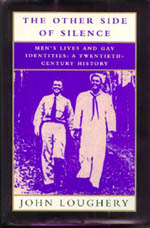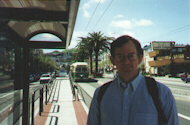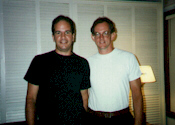 |

 |
|
Jesse's Book Nook
The Other Side of Silence By John Loughery |
|
The Book of the Year: The Other Side of Silence: Men's Lives and Gay Identities: A Twentieth Century History; by John Loughery; A John Macrae Book, Henry Holt and Company; 512 pages; $35.00. [Portions of this article originally appeared in the Lambda Book Report.]
 The most significant gay book of 1998 is the culmination of over two
decades of lesbian and gay scholarship. Historians like Allan Berubé,
George Chauncey, Esther Newton and James Sears recovered and revealed the
lesbian and gay past, showing us how queer people, in different times and
places, lived their lives and built their communities in spite of an
all-powerful opposition. Theirs was a large and fascinating body of work,
and it was only a matter of time before a historian would take that
accumulated knowledge and do for gay men what Lillian Faderman did for
lesbians in Odd Girls and Twilight Lovers.
The most significant gay book of 1998 is the culmination of over two
decades of lesbian and gay scholarship. Historians like Allan Berubé,
George Chauncey, Esther Newton and James Sears recovered and revealed the
lesbian and gay past, showing us how queer people, in different times and
places, lived their lives and built their communities in spite of an
all-powerful opposition. Theirs was a large and fascinating body of work,
and it was only a matter of time before a historian would take that
accumulated knowledge and do for gay men what Lillian Faderman did for
lesbians in Odd Girls and Twilight Lovers.John Loughery is that historian. The Other Side of Silence: Men's Lives and Gay Identities: A Twentieth-Century History covers eighty years of history in the United States, years of great setbacks and great triumphs. These were years of change, in the ways gay men look at ourselves and others look at us. This "still-unfolding process, whereby men who have made other men the focus of their romantic and erotic lives attempt to define themselves (to themselves and to society), wrestle with the narrow images society continues to foist on them, and decide to what extent they should view their sexuality as a defining characteristic of their lives" is "the subject of this book". Charles Kaiser's award-winning history, The Gay Metropolis, covered six decades of gay American history. The Other Side of Silence takes us through eight decades of this still-unfolding process, from the Newport sex scandal of 1919 to the AIDS epidemic and Sex Panic! controversies of today.
Most gay histories deal with such major centers of gay life as Boston, Los Angeles, New York and San Francisco. But The Other Side of Silence also takes us to Boise, Denver, Louisville, New Haven, Omaha and Philadelphia. The Stonewall Uprising, for many of us the central event in modern gay history, is rightly placed at the end of a "maelstrom" year of mounting gay resistance. Though Loughery does not deny the importance of Stonewall, he is quick to remind us that "most gay men and lesbians in the United States did not hear anything about Stonewall until years later". Even those of us who are well-read in the field of gay history will learn something new from The Other Side of Silence. We read how gay men continued to live, work, love, cruise, have sex, find lovers and create literature and art in spite of others' repeated attempts to kill, maim, jail, raid, fire, evict, cure or vote against us. Acts of gay resistance happened all the time, and in the most unexpected places. One of them took place in Dania Beach, then as now a popular gay playground, in the summer of 1962: "A problem that summer was that the stretch of beach where gay sunbathers congregated was under attack from a gang of redneck kids in their dune buggies who thought it was hilarious to drive at top speed across the sand, screaming at the queers, and veering as close to the men on their towels as they could without actually running them over. Not an unheard-of pastime, nor one in which the Florida police would have been especially interested. The influx of gay men to Dania Beach and nearby Fort Lauderdale was more bothersome to the authorities, who had in recent years taken to bringing television cameramen with them on bar raids to further humiliate the arrested patrons. One weekend, a few gay men, most around twenty years old, decided to fight back by burying pieces of wood with protruding nails in the sand to disable the vehicles. To their surprise, they weren't alone on the beach early the next morning. As many as a dozen gay men turned out to help, several with baseball bats. When the riders came by later in the day, their tires got punctured and the occupants jumped out ready for a brawl. When the baseball bats came out from under the beach blankets, the local toughs beat a hasty retreat on foot, and four dune buggies were left in the sand. They were retrieved by their owners during the night - every light, windshield, and hood smashed - and so ended the troubles on the beach. 'They didn't call the police,' Jerry Mitchell of Fort Lauderdale observed, 'either because they didn't want to say a bunch of faggots had sent them running, or they didn't want to deal with us anymore and they knew we'd use the bats. But it had the same result. There's always a limit to how much you're going to take.' "
"In the autumn of 1965, several gay men in Pensacola gathered at the turn-of-the-century manor two of them had recently bought to hatch a plan to acquire the books, magazines, and movies they wanted but were reluctant to order on their own through the mail. Area postal authorities had a habit of opening the plain brown wrappers of deliveries for single men and, between the intelligence officers at the nearby military base and the local police, the existence of a list of the names and addresses of gay men in Pensacola was an open secret. "The idea they came up with was to have a woman they knew open a post office box under a phony name, pool their money for their purchases, and meet once a month in their hosts' ample living room to screen the films and circulate the reading matter. A closed circle; a safe enterprise. And so 'Emma Jones' was born . . . Not an eyebrow was raised at the post office as the packages poured in over the next few years. "But the collective Emma Jones was a restless spirit. By 1966 the four men at the center of social life in Conservative Pensacola were looking for a way to widen their circle of acquaintances and stimulate more socializing . . . They decided that Emma would host a beach party on the weekend of the Fourth of July and sent out twenty-five invitations in her name. Fifty people showed up. The next summer two hundred men and a fair number of women came to roast hot dogs, stuff themselves with shrimp and potato salad, and frolic on a section of the famous Gulf Coast beach of snow-white sand and pure blue water, far from the family section and the gaze of the police. By 1968, with gay men from Mobile, Birmingham, and Tallahassee indicating that they were planning to join the fun, Emma was pleased to think that a need for community was being met far beyond her original impulse and, at her own expense, saw to it that the supplies were ready and the event properly coordinated. More than four hundred people were on hand for the third celebration." To make a long story short, by the early 1970s "Emma Jones" was hosting "the largest gay gathering held in the South to date." Over two thousand men took part in activities which lasted all weekend long and included elaborate drag revues and the Mr. Gay U.S.A. contest. Black and white men partied together in what was still a segregated South. "By the time the event radically changed course in 1974, when the Mafia wanted a piece of the action and local politicians stepped in, innumerable friendships had been made, an example of gay economic clout had been established, and an exuberant gay presence had asserted on the Florida panhandle that, whatever the setbacks ahead, would never disappear entirely." The gay experience on Dania Beach and Pensacola are just two of those "little moments" that, Loughery reminds us, "can be as telling [and] as resonant, as the larger examples." Though these events did not change gay life in Florida, they changed the lives of the men who were involved. Taken individually, these events were life-transforming. Together, they made history. The Other Side of Silence is essential reading for all who are interested in the gay past. Books of the Year: The Other Side of Silence is only the best of many good gay books that appeared in 1998. Here are a few others: 1. An Arrow's Flight, a novel by Mark Merlis; St. Martin's. 2. The Best Little Boy in the World Grows Up by Andrew Tobias; Random House. 3. Dry Bones Breathe: Gay Men Creating Post-AIDS Identities and Cultures by Eric Rofes; Harrington Park. 4. The Empress is a Man: Stories from the Life of Josè Sarria; Haworth. 5. In the Flesh: Undressing for Success by Gavin Geoffrey Dillard; Barricade. 6. Open Secret: Gay Hollywood 1928-1998 by David Ehrenstein; Morrow. 7. Jocks: True Stories of America's Gay Male Athletes; by Dan Woog; Alyson. 8. Opposite Sex: Gay Men on Lesbians, Lesbians on Gay Men, edited by Sara Miles and Eric Rofes; New York University. 9. The Pleasure Principle: Sex, Backlash, and the Struggle for Gay Freedom by Michael Bronski; St. Martin's. 10. Queer 13: Lesbian and Gay Writers Recall Seventh Grade, edited by Clifford Chase; Weisbach/Morrow. 11. Suits Me: The Double Life of Billy Tipton by Diane Wood Middlebrook; Houghton Mifflin. 12. Wisecracker: The Life and Times of William Haines, Hollywood's First Openly Gay Star by William J. Mann; Viking. Previous Book Reviews from the GayToday Archive: The Other Side of Silence The Empress is a Man: Stories from the Life of José Sarria Dry Bones Breathe: Gay Men Creating Post-AIDS Identities and Cultures The Pleasure Principle: Sex, Backlash & the Struggle for Gay Freedom An Arrow's Flight Interview with John Loughery from the GayToday Archive: John Loughery: A Pulitzer Prize Finalist's History of the 20th Century |

 John Loughery
John Loughery  Loughery and his lover of two decades, Tom
Loughery and his lover of two decades, Tom